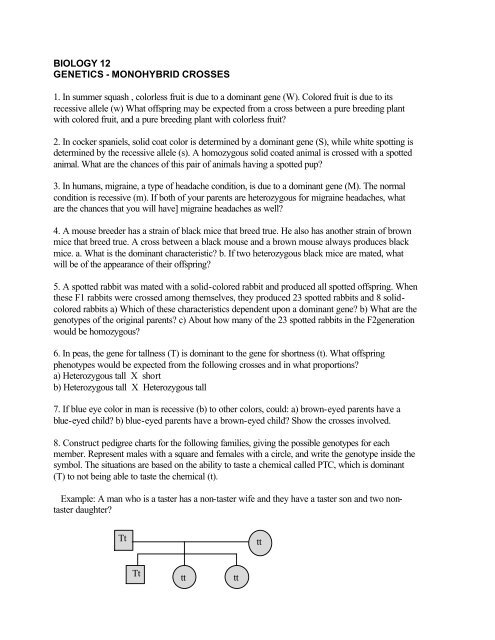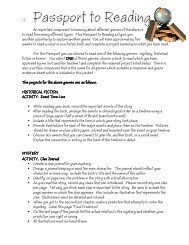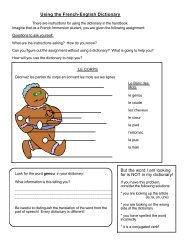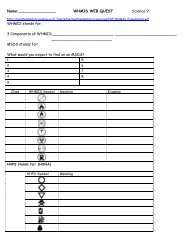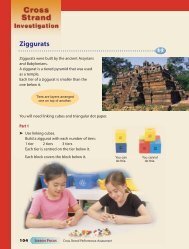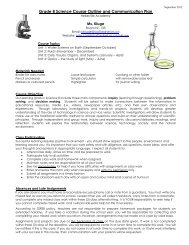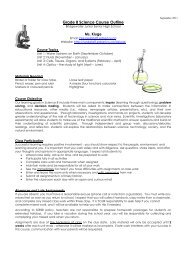Monohybrid questions
Monohybrid questions
Monohybrid questions
Create successful ePaper yourself
Turn your PDF publications into a flip-book with our unique Google optimized e-Paper software.
BIOLOGY 12<br />
GENETICS - MONOHYBRID CROSSES<br />
1. In summer squash , colorless fruit is due to a dominant gene (W). Colored fruit is due to its<br />
recessive allele (w) What offspring may be expected from a cross between a pure breeding plant<br />
with colored fruit, and a pure breeding plant with colorless fruit?<br />
2. In cocker spaniels, solid coat color is determined by a dominant gene (S), while white spotting is<br />
determined by the recessive allele (s). A homozygous solid coated animal is crossed with a spotted<br />
animal. What are the chances of this pair of animals having a spotted pup?<br />
3. In humans, migraine, a type of headache condition, is due to a dominant gene (M). The normal<br />
condition is recessive (m). If both of your parents are heterozygous for migraine headaches, what<br />
are the chances that you will have] migraine headaches as well?<br />
4. A mouse breeder has a strain of black mice that breed true. He also has another strain of brown<br />
mice that breed true. A cross between a black mouse and a brown mouse always produces black<br />
mice. a. What is the dominant characteristic? b. If two heterozygous black mice are mated, what<br />
will be of the appearance of their offspring?<br />
5. A spotted rabbit was mated with a solid-colored rabbit and produced all spotted offspring. When<br />
these F1 rabbits were crossed among themselves, they produced 23 spotted rabbits and 8 solidcolored<br />
rabbits a) Which of these characteristics dependent upon a dominant gene? b) What are the<br />
genotypes of the original parents? c) About how many of the 23 spotted rabbits in the F2generation<br />
would be homozygous?<br />
6. In peas, the gene for tallness (T) is dominant to the gene for shortness (t). What offspring<br />
phenotypes would be expected from the following crosses and in what proportions?<br />
a) Heterozygous tall X short<br />
b) Heterozygous tall X Heterozygous tall<br />
7. If blue eye color in man is recessive (b) to other colors, could: a) brown-eyed parents have a<br />
blue-eyed child? b) blue-eyed parents have a brown-eyed child? Show the crosses involved.<br />
8. Construct pedigree charts for the following families, giving the possible genotypes for each<br />
member. Represent males with a square and females with a circle, and write the genotype inside the<br />
symbol. The situations are based on the ability to taste a chemical called PTC, which is dominant<br />
(T) to not being able to taste the chemical (t).<br />
Example: A man who is a taster has a non-taster wife and they have a taster son and two nontaster<br />
daughter?<br />
Tt<br />
tt<br />
Tt<br />
tt<br />
tt
a) A man and his wife are both tasters and they have two taster sons, a taster daughter, and a nontaster<br />
daughter. One of the sons is married to a non-taster<br />
b) A taster man has a taster son, a non-taster son, and a taster daughter by his first marriage and<br />
two non-taster daughters by his second marriage. His first wife was never tested but his second<br />
wife was a non-taster. The daughter of his first marriage subsequently married a non-taster and<br />
produced eight children, all of whom were tasters.<br />
9. In sheep, white is due to a dominant gene (W). Black is due to its recessive allele (w). A white<br />
ewe mated to a white ram produces a black lamb. If they produce another offspring, could it be<br />
white? If so, what are the chances of its being white? Show the cross.<br />
10. In humans, normal skin pigmentation is due to a dominant gene (N) and albinism to its<br />
recessive allele (n). A normal man marries an albino woman and their first child is an albino. What<br />
are the genotypes of all three persons? If there are more children what would they probably be<br />
like? Show the cross.<br />
11. A normally pigmented man whose father was an albino marries an albino woman, whose<br />
parents were normally pigmented. They have three children, 2 normally pigmented and one albino.<br />
List the genotypes of all these persons and show the crosses.<br />
12. Albinism frequently skips a generation in human pedigrees while polydactyly (extra fingers)<br />
does not. How do you explain these facts?<br />
13. In cattle, a recessive lethal gene (l) causes calves to be born "amputated" with malformed limbs<br />
and head and internal abnormalities which soon causes death. The normal situation is caused by a<br />
dominant gene (L).<br />
a) Show the possible results of a cross between two animals both heterozygous for this allele.<br />
b) Could two animals both homozygous normal produce an amputated calf? Show the cross.<br />
14. In poultry, rose comb is dependent upon a dominant gene(R) and single comb upon its recessive<br />
allele (r). Birds of the Wyandotte breed are required to have rose combs. In certain strains of<br />
Wyandottes, single comb birds occasionally occur. Why is this? Show the cross.<br />
15. Wyandotte breeders never use a single comb bird for breeding. When one appears in a flock, it<br />
is discarded. Will this practice eliminate the gene for single comb in the flock? Explain.<br />
16. It is assumed that the probability of a child being of a particular sex is 1/2. If a couple have 2<br />
children, both boys, what is the probability that their third child will be a boy?<br />
17. The ability to roll the tongue in humans is dominant (R) while non-rolling is recessive(r). a)<br />
could two "tongue-rollers produce a "non-rolling child? Show the cross. b) What would be the<br />
possible results if a homozygous roller and a non-roller have children? Show the cross.<br />
18. The gene for yellow seed (Y) coat in peas is dominant to its allele for green seed cost (y). What<br />
offspring phenotypic ratio would be expected from a cross between a pea plant known to be<br />
heterozygous for coat color and one which produced green seeds? Show the cross.
19. The polled or hornless condition (P) in cattle is dominant over the horned condition (p). A<br />
certain polled bull is mated to three cows. (i) With cow A, which is horned, a polled calf is<br />
produced. (ii) White cow B, also horned, a horned calf is produced. (iii) Cow C is polled and a<br />
horned calf is produced. What are the genotypes of all animals involved. Show the crosses.<br />
20. In sheep, white wool is produced by a dominant gene(W) and black wool by its recessive<br />
allele(w). If a homozygous white sheep were crossed with a black sheep<br />
a) What would the result be?<br />
b) What would the F 2 result be?<br />
21. In the fruit fly, red eyes are produced by the dominant gene (R) and sepia eyes by its recessive<br />
allele (r). If 2 heterozygous organisms are crossed, what will be the probable results?<br />
22. In fruit flies, the gene for long wing (L) dominates over its allele for vestigeal wing (l). In a<br />
cross between a heterozygous long winged male and a homozygous long winged female, what will<br />
be the probable results?<br />
23.In Holstein cattle, the spotting of the coat is due to a recessive gene (s) while a solid color coat is<br />
dominant (S) What will be the probable results if 2 spotted animals are crossed?


